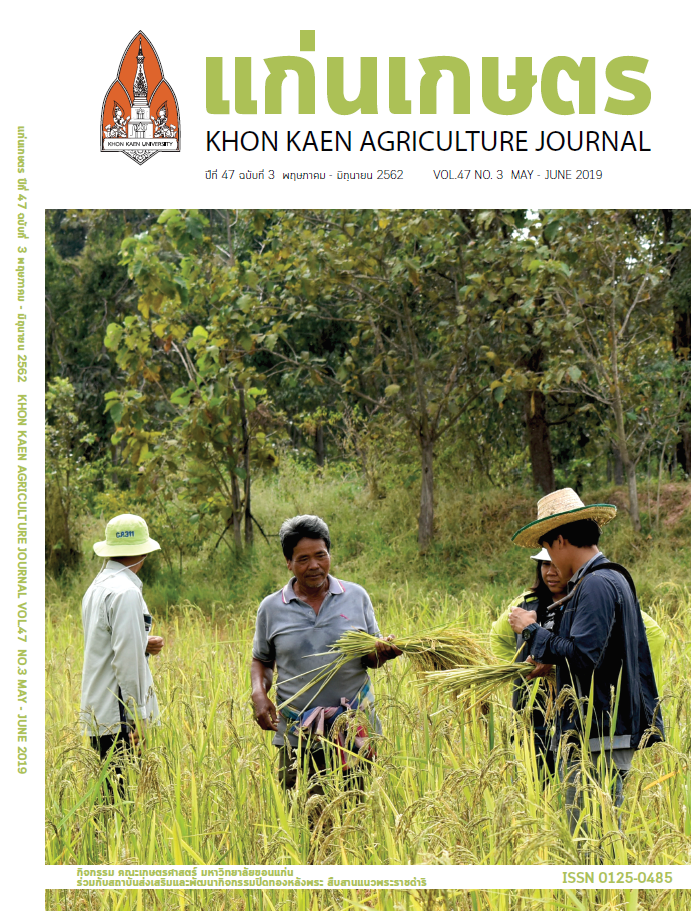การแสดงออกของยีน CIPK15 ในพันธุ์ข้าวไทยภายใต้สภาพน้ำท่วม
Main Article Content
บทคัดย่อ
ข้าวบางพันธุ์มีความสามารถในการปรับตัวของการงอกและเจริญเติบโตภายใต้สภาวะน้ำท่วม เนื่องจากสภาพขาดออกซิเจนระหว่างการงอกส่งผลต่อการเจริญเติบโตและผลผลิตในข้าว ยีน CIPK15 เกี่ยวข้องกับการปรับตัวในส่วนการงอกของข้าวต่อสภาพน้ำท่วม ดังนั้นงานวิจัยนี้มีวัตถุประสงค์เพื่อประเมินการแสดงออกของยีน CIPK15 ในระยะต้นกล้าภายใต้สภาพน้ำท่วมและสภาพน้ำไม่ท่วมเป็นเวลา 14 วัน ศึกษาในข้าวจำนวน 11 พันธุ์ วางแผนการทดลองแบบ 2 x 11 Factorial in Completely Randomized Design จำนวน 3 ซ้ำ พบว่าภายใต้สภาพน้ำท่วม ข้าวมีการแสดงออกของยีน CIPK15 แตกต่างกันอย่างมีนัยสำคัญทางสถิติ (P<0.05) เมื่อเปรียบเทียบ สัดส่วนการแสดงออกของยีน CIPK15 ระหว่างสภาพน้ำท่วมกับสภาพน้ำไม่ท่วมสามารถแบ่งข้าวได้เป็น 2 กลุ่ม คือ กลุ่มที่ 1 ได้แก่ พันธุ์ กข 19 และกลุ่มที่ 2 ได้แก่ พันธุ์ขาวโป่ งไคร้, น้ำรู, อาร์ 258, ขาวดอกมะลิ 105, เหนียวเขี้ยวงู, ปทุมธานี 1, กข 10, กข 14, สันป่ าตอง 1 และสุพรรณบุรี 1 การแสดงออกของยีน CIPK15 พบว่าพันธุ์ กข 19 แสดงสัดส่วนการแสดงออกของยีน CIPK15 ระหว่างสภาพน้ำท่วมกับสภาพน้ำไม่ท่วมสูงที่สุด การศึกษาลำดับนิวคลีโอไทด์ของยีน CIPK15 พบว่าพันธุ์ กข 19 มีลำดับนิวคลีโอไทด์แตกต่างจากข้าวปลูกทั ้ง 10 พันธุ์ แต่มีลำดับนิวคลีโอไทด์เหมือนกับข้าวป่าสามัญ (O. rufipogon) ส่วนข้าวทั้ง 10 พันธุ์ พบว่ามีลำดับนิวคลีโอไทด์ของยีน CIPK15 เหมือนกัน การวิเคราะห์ haplotype network แสดงว่าข้าวพันธุ์ กข 19 ถูกจัดให้อยู่ในhaplotype เดียวกับข้าวป่ าสามัญ (haplotype 1) ส่วนข้าวอีก 10 พันธุ์ถูกจัดกลุ่มให้อยู่ในกลุ่มเดียวกันคือ haplotype 2 เมื่อนำข้อมูลมาเชื่อมโยงกันแล้วข้าวพันธุ์ กข 19 ที่เป็นพันธุ์ข้าวน้ำลึกมีการปรับตัวต่อสภาพน้ำท่วมในระหว่างการงอกโดยสัดส่วนการแสดงออกของยีน CIPK15 ระหว่างสภาพน้ำท่วมกับสภาพน้ำไม่ท่วมสูง ผลที่ได้จากการศึกษานี้สามารถนำไปพัฒนาเครื่องหมายโมเลกุลเพื่อใช้ในการคัดเลือกในโครงการปรับปรุงพันธุ์ข้าว ให้ทนต่อสภาพน้ำท่วมต่อไป
Article Details
เอกสารอ้างอิง
กรมส่งเสริมการเกษตร. 2560. การปรับปรุงทะเบียนเกษตรกร. แหล่งข้อมูล: http://farmer.doae.go.th/ecoplant/eco_report/report10_rice. ค้นเมื่อ 1 พฤศจิกายน 2561.
กระทรวงเกษตรและสหกรณ์. 2560. รายงานสถานการณ์ ภัยพิบัติด้านการเกษตร. แหล่งข้อมูล: https://www.moac.go.th/service_all-agriculture_situation. ค้นเมื่อ 2 พฤศจิกายน 2561.
สำนักงานวิจัยและพัฒนาข้าว. 2560. การเพาะปลูกข้าว. แหล่งข้อมูล: http://www.arda.or.th/kasetinfo/rice/rice_cultivate_species. html. ค้นเมื่อ 16 มีนาคม 2561.
สำนักงานวิจัยและพัฒนาข้าว. 2561. ฐานข้อมูลพันธุ์ข้าวรับรองของไทย. แหล่งข้อมูล: http://brrd.ricethailand.go.th/rvdb/. ค้นเมื่อ 20 กุมภาพันธ์ 2561.
สำนักวิจัยและพัฒนาข้าว. 2561. องค์ความรู้เรื่องข้าว. แหล่งข้อมูล: http://www.ricethailand. go.th/Rkb/varieties/index.phpfile=content.php&id=7.htm. ค้นเมื่อ 2 มีนาคม 2561.
อภิชาติ วรรณวิจิตร, สมวงษ์ ตระกูลรุ่ง, สุรพงษ์ สาคะรัง, ปนัดดา พีคะสูต และสมหมาย อมรศิลป์ . 2540. การปรับปรุงพันธุ์ข้าวทนน้ำท่วม. สถาบันวิจัยและพัฒนาแห่งมหาวิทยาลัยเกษตรศาสตร์.
Al-Ani, A., F. Bruzau, P. Raymond, V. Saint-Ges, J. M. Leblanc, and A. Pradet. 1985. Germination, respiration and adenylate energy charge of seeds at various oxygen partial pressures. Plant Physiol. 79: 885–890.
Atwell, B. J. and H. Greenway. 1987. Carbohydrate metabolism of rice seedlings grown in oxygen-deficient solution. J Exp Bot. 38: 466–478.
Bandelt, H. J., P. Forster and A. Rohl. 1999. Median-joining networks for inferring intraspecific phylogenies. Mol Biol Evol. 16: 37-48.
Bewley, J. D. and M Black. 1985. Seeds: physiology of development and germination. Plenum Press. New York.
FAO. 2018. AGP - What are sustainable rice systems. Available: http://www.fao.org/agriculture/crops/thematic-sitemap/theme/spi/scpi-home/managingecosystems/sustainable-rice-systems/rice-what/en/. Accessed Nov. 14, 2001.
Hunt, R., Z. E. Sauna, S. V. Ambudkar, M. M. Gottesman, and C. Kimchi-Sarfaty. 2009. Silent (synonymous) SNPs: should we care about them?. Methods Mol Biol. 578: 23–39.
Hwang, Y. S., B. R. Thomas, and R. L. Rodriguez. 1999. Differential expression of α-amylase genes during seedling development under anoxia. Plant Mol Biol. 40: 911–920.
Ismail, A. M., E. S. Ella, G. V. Vergara, and D. J. Mackill. 2009. Mechanisms associated with tolerance to flooding during germination and early seedling growth in rice (Oryza sativa). Ann Bot. 103: 197–209.
Ilagan, L. A., R. P. Tablizo, R. B. Barba Jr, and N. A. Marquez. 2014. Soil fertility evaluation for rice production in Catanduanes Province, Philippines. IJSTR. 3: 81-87.
Jackson, M. B. 2004. The Impact of Flooding Stress on Plants and Crops. Available: http://www.plantstress.com/Articles/waterlogging_i/waterlog_i.htm. Accessed Jul. 3, 2017.
Kudahettige, N. P., C. Pucciariello, S. Parlanti, A. Alpi, and P. Perata. 2011. Regulatory interplay of the Sub1A and CIPK15 pathways in the regulation of α-amylase production in flooded rice plants. Plant Biol. 13: 611–619.
Kumar, S., G. Stecher, and K. Tamura. 2016. MEGA7: Molecular Evolutionary Genetics Analysis version 7.0 for bigger datasets. Mol Biol Evol. 33: 1870–1874.
Lee, K. W., P. W. Chen, C. A. Lu, S. Chen, T. H. David Ho, and S. M. Yu. 2009. Coordinated responses to oxygen and
sugar deficiency allow rice seedlings to tolerate flooding. Sci Signal. 2: ra61.
Lee, K. W., P. W. Chen, and S. M. Yu. 2014. Metabolic adaptation to sugar/O2 deficiency for anaerobic germination and seedling growth in rice. Plant Cell Environ. 37: 2234–2244.
Librado, P. and J. Rozas. 2009. DnaSP v5: A software for comprehensive analysis of DNA polymorphism data. Bioinformatics. 25: 1451-1452.
Morishima, H., Y. Sano, and H. I. Oka. 1984. Differentiation of Perennial and Annual Types Due to Habitat Conditions in the Wild Rice Oryza perennis. Pl. Syst. Evol. 144: 119–135.
Park, M., H. K. Yim, H. G. Park, J. Lim, S. H. Kim, and Y. S. Hwang. 2010. Interference with oxidative phosphorylation enhances anoxic expression of rice alpha-amylase genes through abolishing sugar regulation. J Exp Bot. 61: 3235–3244.
Perata, P., J. Pozueta-Romero, T. Akazawa, and J. Yamaguchi. 1992. Effects of anoxia on starch breakdown in rice and wheat seeds. Planta. 188: 611–618.
Pusadee, T., B. Schaal, B. Rerkasem, and S. Jamjod. 2013. Population structure of the primary gene pool of Oryza sativa in Thailand. Genet Resour Crop Evol. 60: 335-353.
Pusadee, T., S. Jamjod, B. Rerkasem, and B. Schaal. 2016. Life-history traits, and geographical divergence in wild rice (Oryza rufipogon Griff.) gene pool in Indochina Peninsula region. Ann. Appl. Biol. 168: 52-65.
Sarobol, E. 2011. Mechanisms of plant responses to global climate change. KHON KAEN AGR. 39: 22-26.
Wongtamee, A., C. Maneechote, T. Pusadee, B. Rerkasem, and S. Jamjod. 2017. The dynamics of spatial and temporal population genetic structure of weedy rice (Oryza sativa f. spontanea Baker). Genet Resour Crop Evol. 64: 23-39.


